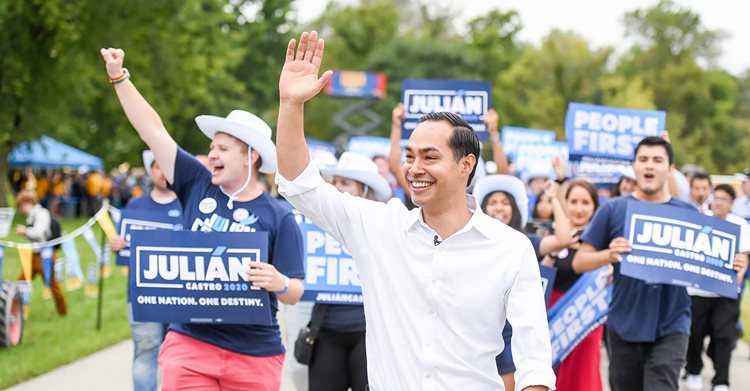
Castro Saw Difference While a Candidate
Homepage photo illustration by Shevry Lassiter
Support Journal-ismsCastro Saw Difference While a Candidate
“I could see in my own campaign on the trail,” Julián Castro (pictured) was saying, “that journalists of color often got the nuance.” They covered the campaign “much more solidly and were willing to put that [nuance] in the stories more.
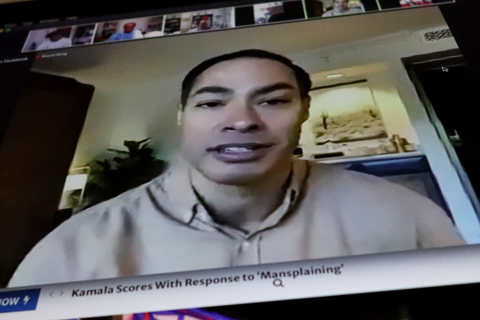 “We know that in newsrooms around the country, from the most prestigious papers to local newspapers, that are covering important community issues, the mainstream media have done a terrible job, just like Hollywood and much of corporate America, especially Silicon Valley, with diversity.”
“We know that in newsrooms around the country, from the most prestigious papers to local newspapers, that are covering important community issues, the mainstream media have done a terrible job, just like Hollywood and much of corporate America, especially Silicon Valley, with diversity.”
Castro is the former Obama housing secretary and mayor of San Antonio who competed with Joe Biden, Kamala Harris and others this campaign season for the Democratic presidential nomination.
The Sunday he spoke, Oct. 18, he was in Arizona campaigning for the Biden-Harris ticket and dialing into the Journal-isms Roundtable’s Zoom call (video) (narrative and photos) (column). He predicted that Latinos could be prime players in determining every general election, with states such as Texas (38 electoral votes), Arizona (11) and Georgia (16) added to Florida (29) as places where Latinos could determine the outcome. He was elated by the “massive interest, tremendous interest” evidenced in the early turnout in Texas.
Castro also said the news media had learned lessons from the 2016 race, when networks gave Donald Trump too much free airtime, but said he would “be fascinated” to see the figures comparing the time allotment Biden and Trump each received. He believes Trump got more. (At least regarding CNN, Castro was right).
Castro also said the news media had become somewhat more responsible after having given Hillary Clinton emails outsized coverage in 2016, but was critical of Facebook and Twitter for transmitting disinformation.
Journal-isms took the question of campaign press corps diversity Saturday to a Zoom meeting of the Baltimore Association of Black Journalists. It wasn’t hard to find examples of faux pas — remember Chelsea Janes, the Washington Post’s former sports reporter who didn’t get the trademark “skee-wee” call that sorors of Alpha Kappa Alpha sounded during a Kamala Harris event”? She called it a “screech.”
Yet there are also new Black voices on the campaign trail this year, such as Astead Herndon of The New York Times and Errin Haines of the female-focused site The 19th. However, a pandemic-caused change of deployment makes it more difficult to compare this year’s press corps with that of 2016.

Generational markers were also apparent among African American voters, Courtland Cox, chair of the Legacy Committee of the Student Nonviolent Coordinating Committee, told the 51 people on the call and the hundreds watching via Facebook. Cox is working with the NAACP’s registration efforts this year.
Cox, 79, considers himself part of the “Emmett Till group,” influenced by the 1955 lynching of the 14-year-old Till in Mississippi for allegedly whistling at a white woman. Then there is the “Trayvon Martin group,” affected most by the 2012 Florida killing of the 17-year-old by self-appointed neighborhood watchman George Zimmerman. Finally, there is the George Floyd group, driven to action by the Memorial Day killing of Floyd this year by Minneapolis police. All those slain were Black.
The Till generation faced a stronger “police state” in the Deep South and demonstrators realized they might be killed, Cox said. The Floyd and Martin generations started out thinking “that at the end of the day that the battle is in the streets, and that they need to be in the streets,” but Cox said “they become more and more sophisticated as the time goes on.” They will realize that real change requires political power.
“One thing that the Trump administration has done is clarified for many of the young activists the need to vote,” Cox said. “There are no more discussions any more with them about what the need is.”
On Oct. 13, the NAACP’s “civic engagement campaign” began reaching out to high-propensity African American voters in the 10 battleground states and charged them with reaching out to 7.5 million low-propensity voters in those jurisdictions to get them to the polls.
When Mary C. Curtis of CQ/Roll Call called Texas “Ground Zero” for voter suppression, Castro agreed. Such tactics as cutting the number of polling places are well known, less so are the measures used against Native Americans and Asian Americans. With both groups, failure to provide information in non-English languages can be problematic.
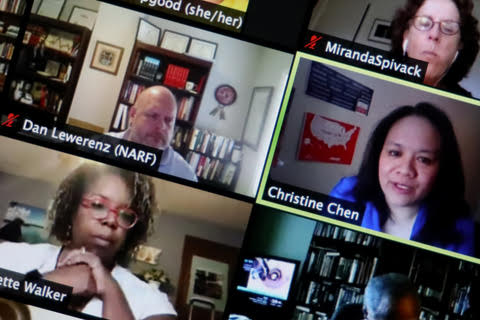
Dan Lewerenz, a staff attorney with the Native American Rights Fund and former president of the Native American Journalists Association, discussed court challenges to curtailing early voting initiatives in Indian Country, requiring more than one signature on ballots, or a Montana law that tried to prevent one person from handling another’s ballot.
In Indian Country, many homes do not receive daily mail service, which means some must rent post office boxes. Families share them and carry each other’s mail in doing so.
For Asian Americans, sometimes simply being in the conversation is the issue.
Who knew, for example, that among Asian Americans, Vietnamese Americans are more likely to be Republican (38 percent of those polled), believing that the GOP is more anticommunist?
“It’s not being reported out that Asian Americans are contracting COVID at higher rates, and it’s not necessarily being seen and heard, especially the Pacific Islander communities,” said Christine Chen, executive director of Asian and Pacific Islander American Vote (APIAVote). Chen held up her group’s 2020 Asian American Voter Survey as a resource.
“Even after the election, this data can be used when you’re covering different issues. Because as we all know, after this is over, it’s all about holding the elected officials accountable. . . . For instance, gun control is a huge issue; as far as environmental issues, at the same time, we never see environmentalists and gun control advocates reaching out to Asian American voters, or being talked about in the coverage, so we have data points that can be included in your stories as well.”
This was the first Roundtable for Maudlyne Ihejirika, reporter and columnist for the Chicago Sun-Times. “Loved the family gathering feel . . . and got a lot of insight I can use going into the election,” she wrote afterward.
The “family” offered congratulations and toasts to Calvin Sims, CNN’s new executive vice president of standards and practices, and Mei-Ling Hopgood of Northwestern University’s Medill School of Journalism, Media, Integrated Marketing Communications, winner of the Barry Bingham Sr. fellowship. The award is given to an educator who has championed diversity. Hopgood was introduced by her dean, Charles Whitaker.
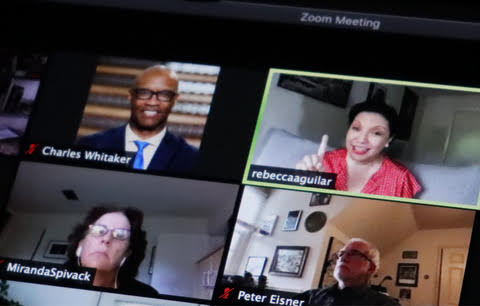
Rebecca Aguilar was toasted on becoming president-elect of the Society of Professional Journalists, the first Latina and woman of color in that role, along with Ivette Davila-Richards, who was elected secretary-treasurer.
Of the nine-member SPJ board, four are people of color, Aguilar noted “That says a lot. . . . SPJ is sending a clear message, that we’re not just going to talk the talk; we’re going to walk the walk.”
Sims, who has worked at The New York Times, the Ford Foundation and International House, said, “I’ve been wanting to return to journalism for some time, and I can’t think of a more momentous time to be doing it than right now.”
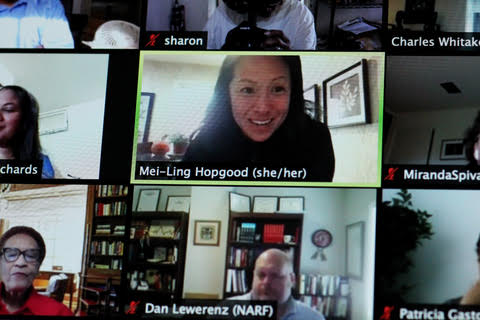
Hopgood, responding to a question, found it “pretty amazing that enrollment in journalism schools [is] up despite the turbulence, and I think you know that these young people are just inspirational in t]hat they really do want to make a difference, and they still believe that journalism can still be a vehicle for that.”
Hopgood also said, “They come from a different spot where they have different expectations of diversity, equity and inclusion work. They come in, many of them, not all, with a different formation of how the world should work and how it should treat people. . . . They have higher expectations of our industry.”
- Acee Agoyo, indianz.com: ‘Trump is hitting us really hard’: Biden campaign confronts last minute push for Native vote
- Jon Allsop and Pete Vernon, Columbia Journalism Review: How the press covered the last four years of Trump
- Gustavo Arellano, Los Angeles Times: Trump inspired them to become U.S. citizens and to vote. Against him
- Cecilia Ballí, Texas Monthly: Don’t Call Texas’s Latino Voters the “Sleeping Giant”
- Monika Bauerlein and Clara Jeffery, Mother Jones: Facebook Manipulated the News You See to Appease Republicans, Insiders Say
- Kelsey Carolan, Texas Tribune: In Democrats’ bid to flip Texas, maximizing the Latino vote is key
- Jelani Cobb, “Frontline,” PBS: “Whose Vote Counts” (video) (Oct. 20)
- The Crisis, NAACP: Voting Supplement
- Nick Fouriezos, Ozy: Dem Fear in Ohio: Repeat of 2016 Blunder With Black Voters
- Renée Graham, Boston Globe: Voter suppression is democracy bleeding out (Oct. 13)
- Earl Ofari Hutchinson, the Hutchinson Report: The Electoral College How it Works (video)
- Mathew Ingram, Columbia Journalism Review: Yes, we’re doing it all over again (Oct. 15)
- Morgan Lee, Associated Press: Watchdog group cites interference at polls in Latino areas
- Sophie Long, BBC: US Election 2020: Why Arizona matters so much to Trump and Biden (Oct. 13)
- Alex Samuels, Texas Tribune: Why Asian American voters in Texas may hold outsized importance in key races this year
- Calah Schlabach, Cronkite News: Court: Mailed Navajo ballots should not get extra time to be counted (Oct. 15)
- Nina Shapiro, Seattle Times: Among Vietnamese American voters, the Trump-Biden presidential race inflames old wounds (Oct. 17, updated Oct. 19)
- Marlow Stern, Daily Beast: Jeff Zucker on the Big ‘Mistake’ CNN Made Covering Trump and His Regret Over Hillary’s Emails (Oct 14, updated Oct. 15)
- Rudy Takala, Mediaite: NBC News Predicts Texas Moving Toward Biden
- Chris Uggen, Ryan Larson, Sarah Shannon, and Arleth Pulido-Nava, The Sentencing Project: Locked Out 2020: Estimates of People Denied Voting Rights Due to a Felony Conviction (Oct. 14)
To subscribe at no cost, please send an email to journal-isms-subscribe@yahoogroups.com and say who you are.
Facebook users: “Like” “Richard Prince’s Journal-isms” on Facebook.
Follow Richard Prince on Twitter @princeeditor
Richard Prince’s Journal-isms originates from Washington. It began in print before most of us knew what the internet was, and it would like to be referred to as a “column.” Any views expressed in the column are those of the person or organization quoted and not those of any other entity. Send tips, comments and concerns to Richard Prince at journal-isms-owner@yahoogroups.com
View previous columns (after Feb. 13, 2016).
- Diversity’s Greatest Hits, 2018 (Jan. 4, 2019)
- Book Notes: Is Taking a Knee Really All That? (Dec. 20, 2018)
- Book Notes: Challenging ’45’ and Proudly Telling the Story (Dec. 18, 2018)
- Book Notes: Get Down With the Legends! (Dec. 11, 2018)
- Journalist Richard Prince w/Joe Madison (Sirius XM, April 18, 2018) (podcast)
- Richard Prince (journalist) (Wikipedia entry)
- February 2018 Podcast: Richard “Dick” Prince on the need for newsroom diversity (Gabriel Greschler, Student Press Law Center, Feb. 26, 2018)
- Diversity’s Greatest Hits, 2017 — Where Will They Take Us in the Year Ahead?
- Book Notes: Best Sellers, Uncovered Treasures, Overlooked History (Dec. 19, 2017)
- An advocate for diversity in the media is still pressing for representation, (Courtland Milloy, Washington Post, Nov. 28, 2017)
- Morgan Global Journalism Review: Journal-isms Journeys On (Aug. 31, 2017)
- Diversity’s Greatest Hits, 2016
- Book Notes: 16 Writers Dish About ‘Chelle,’ the First Lady
- Book Notes: From Coretta to Barack, and in Search of the Godfather
- Journal-isms’ Richard Prince Wants Your Ideas (FishbowlDC, Feb. 26, 2016)
- “JOURNAL-ISMS” IS LATEST TO BEAR BRUNT OF INDUSTRY’S ECONOMIC WOES (Feb. 19, 2016)
- Richard Prince with Charlayne Hunter-Gault,“PBS NewsHour,” “What stagnant diversity means for America’s newsrooms” (Dec. 15, 2015)
- Book Notes: Journalists Follow Their Passions
- Book Notes: Journalists Who Rocked Their World
- Book Notes: Hands Up! Read This!
- Book Notes: New Cosby Bio Looks Like a Best-Seller
- Journo-diversity advocate turns attention to Ezra Klein project (Erik Wemple, Washington Post, March 5, 2014)
.

